| Your browser is not supported. | ||
|
Please browse our site using any of the following options:
| ||
Your ultimate guide to 4WDing on sand
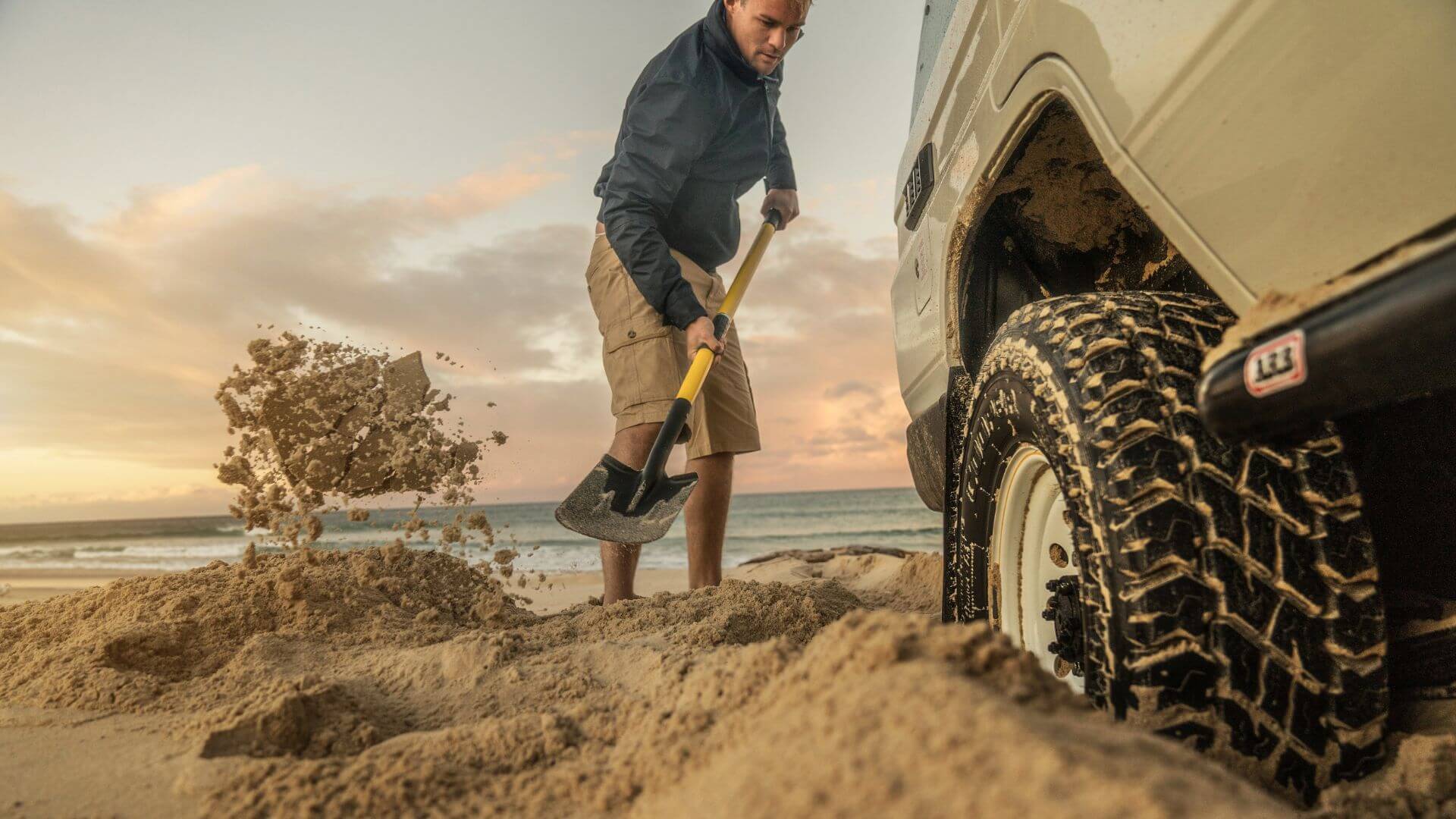
Many people know places like Minjerribah North Stradbroke Island, K'gari Fraser Island and Cable Beach in Western Australia as legendary 4X4 beach driving encounters, but they're just a taste of what 4X4 driving on sand can be like.
Not only is 4WD beach driving an exhilarating way to explore some of Australia's more isolated coastlines and waterways, it's often the best method to access some truly remarkable fishing, camping and hiking spots that put the 'great' in the great Australian outdoors.
Driving on sand isn't like normal driving, though - it requires preparation, planning and patience. So, with that in mind, here is our guide to 4WDing on beaches and other sandy stretches.
Getting Ready To Hit The Sand
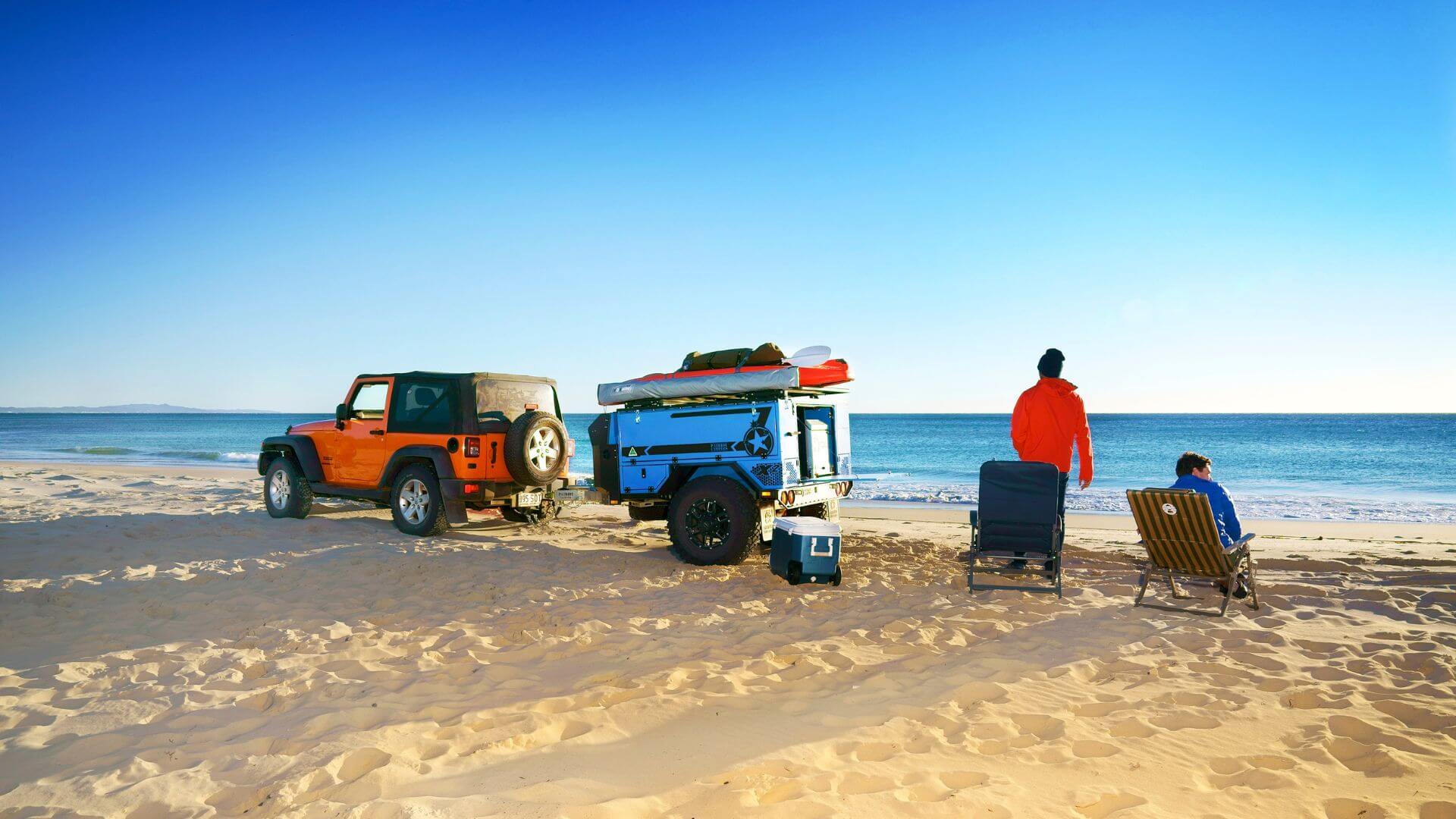
Make sure your 4WD is off-road-ready
One of the most important steps when preparing for 4WD beach driving is ensuring your 4X4 is in good working order. Driving on the beach puts considerable strain on the engine and drivetrain, so getting your vehicle serviced before leaving is a good idea.
As 4WD enthusiast Daniel Sands explains, a sandy beach "is not somewhere you want to experience a mechanical failure. If roadside assistance services aren't able to reach you and your 4WD, then a tow truck recovery from the beach can be quite a costly exercise."
Daniel recommends checking all of your essential vehicle fluids - like engine oil, brake fluid, clutch fluid, and power steering fluid - prior to setting off: "These checks take five minutes and could mean the difference between a successful trip and a mechanical failure."
If your 4WD is fitted with a winch, you should definitely check it's working properly before beginning your adventure.
Furthermore, protecting your car's chassis and underbody against saltwater contamination is something you need to bear in mind. The amounts of saltwater you'll be driving through can inflict serious damage in the long term. That's why Aaron Schubert from 4WDing Australia recommends coating the underside with lanolin.
"4WD vehicles that are not well cared for after being driven on the beach will rust quickly and cost a lot of money to fix," Aaron says. "Lanolin works well. You can buy this (basically, just sheep oil) from Bunnings and Repco, and spray it on the underneath of your car before you drive on the beach. Give it at least a day to drive, as it is sticky as. When you come back, be sure to hose everything off again."
Always be aware of your 4WD's dimensions and height clearance. Some drivers get themselves into trouble that could have been easily avoided by knowing the car's limitations. If you're not sure what your 4WD's dimensions and height clearances are, your owner's manual will have the info you need.
Pack the right gear
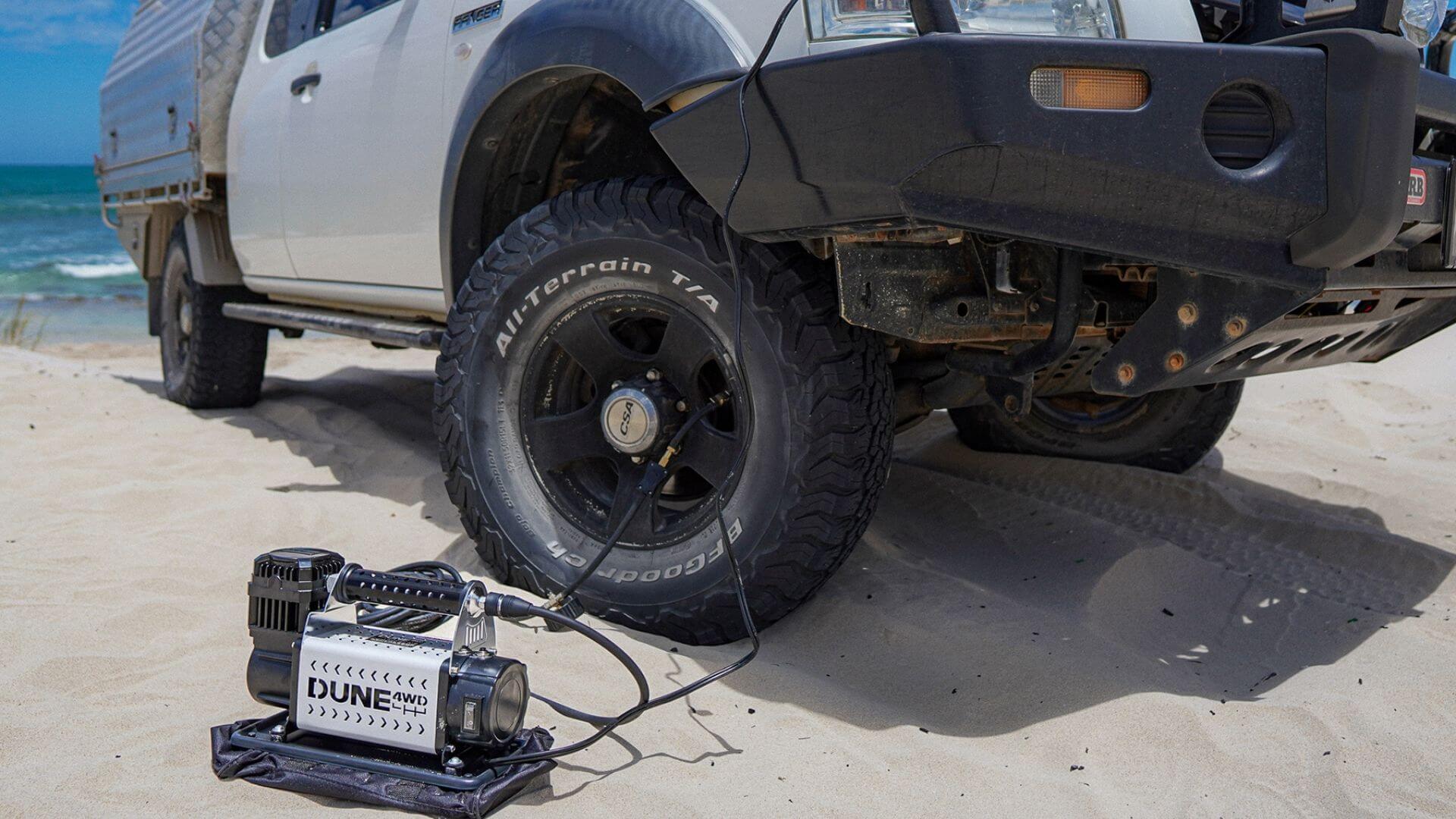
Once your vehicle is mechanically ready, the next step is to pack all the necessary gear to navigate the beach and get home safely afterwards, no matter what challenges you face.
A tyre deflator - ideally with a pressure gauge - is among the first things you should pack when planning some beach driving. A tyre deflator makes reducing the air pressure in your tyres for driving on sand easy, and ensures you don't deflate your tyres too much and damage them.
Likewise, a 12V compressor is a 4WD beach driving essential. It makes re-inflating your tyres fast for the trip home after leaving the beach, and saves you heaps of time and energy when compared to using a hand or foot pump. Driving on the road with under-inflated tyres will cause premature wear and tear, not only to your tyres but, most importantly, to your wheels.
Packing recovery gear means, when you get stuck - because the reality is, at one time or another, you ARE going to get stuck - you're well-prepared. Self-recovery equipment such as recovery boards, shovels, snatch straps and dampers and tyre repair kits are essential. When shopping for recovery boards, look for ones designed to work as shovels, and long-handled shovels are better for reducing lower back strain when digging your car out of trouble.
Additionally, your recovery pack should include SPF50+ sunscreen (imagine shovelling sand in the heat of the day without it!), a UHF radio for really remote areas (where there aren't many other travellers around and when you may need some recovery help) and always have plenty of water on board your 4WD, so you and the people with you stay hydrated in case of a breakdown or emergency.
Driving On The Beach
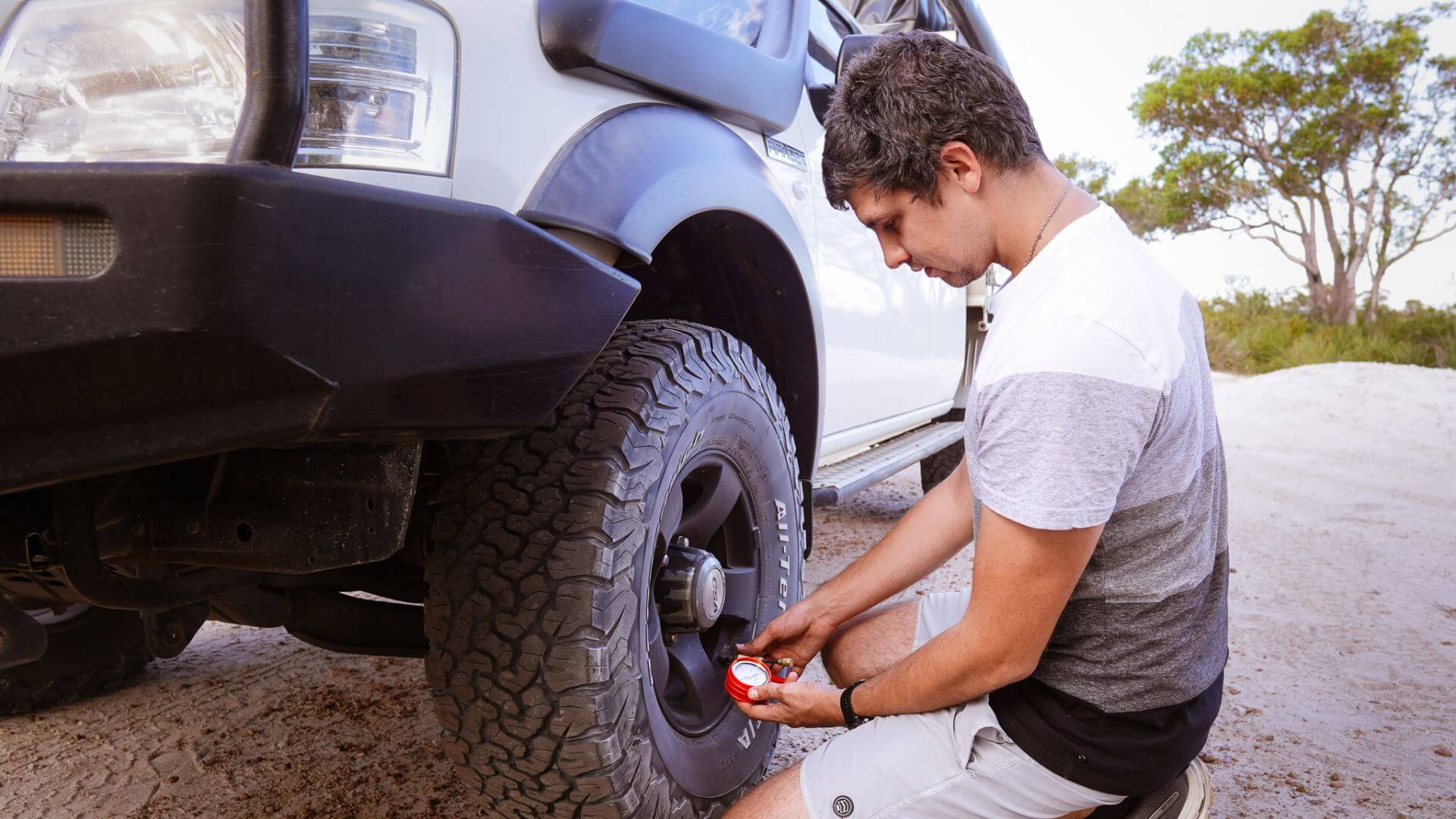
Tyre pressures
The first part of getting ready to drive on sand is to remove some of the air from your tyres. Lowering the air pressure helps improve traction. By giving your wheels a greater surface area, you're increasing the vehicle's grip.
As motoring writer Dom Wiseman explains, "Lowering your tyre pressure allows the tyre to create a greater tread footprint, allowing the vehicle to float on top of the sand, and thereby less likely to get stuck in it. It is the number-one factor in determining how your vehicle performs on this type of terrain."
Every beach or sand area is different, and 4WDs handle differently depending on their make, model and variant. In other words, there's no one-size-fits-all number for lowering your tyre pressure.
The best way to find out the 'right' pressure for the area where you're driving is to ask another nearby driver, or do some trial and error of your own. This is where your tyre deflator and pressure reader pay for themselves. Start by dropping pressure to, say, 25kpa/psi and see how that feels. If your engine's working too hard in low gear, begins heating up and you're not making much headway, drop the tyre pressures a bit more. Keep dropping pressure until you find a good grip and your 4X4 isn't revving its head off.
For safety reasons, and to protect your tyres and rims, it's recommended you shouldn't go below 15-16 psi/kpa. Tyre pressures below 15psi/kpa increase the risk of damaging the sidewalls of the tyres when turning, or worse, popping them off the wheel rims altogether.
Driving style and gear selection
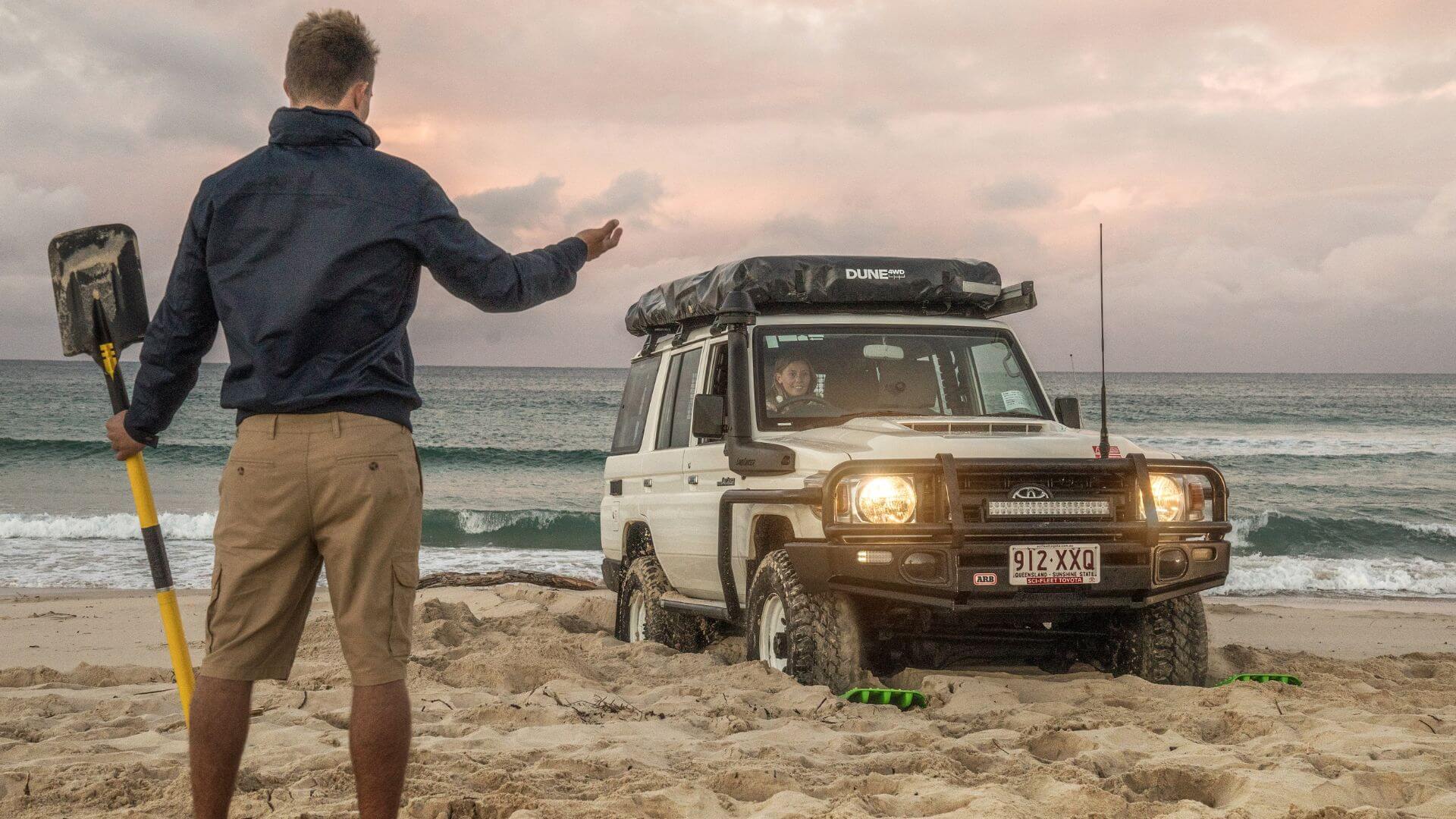
Your 4x4's in top nick, you've packed the essentials and you've adjusted your tyre pressures. Now comes the fun part: driving on the sand.
First, forget what you've seen on telly or YouTube where you're watching professional drivers at work in carefully stage-managed conditions. In the real world, sharp turns at speed might look great, but that kind of driving style can end up with you rolling your 4X4 or ripping your (very pricey) tyres from their rim. Or both.
Pre-existing tracks are likely to be firmer and provide better traction so, as much as you're sand driving for an off-the-beaten-path experience, it's better to stick to existing trails to avoid obstacles hidden in softer sand that could seriously damage your 4WD.
The trick to effective, enjoyable and safe driving on the beach is having forward momentum, and, as Dom Wiseman mentioned above, "floating" or staying on top of the sand as much as you can.
The key to getting that momentum happening is being in the right gear and always having your 4WD mode engaged. It's also important to have your 4X4's locking hubs engaged too.
Start slowly and get a feel for how your 4WD responds. Low-range gears give you more torque, so use your low-range gearbox. You'll also need to keep your revs up higher than you normally would when diving on standard, sealed roads. If you have an automatic gearbox in your 4X4, it will mostly do the job for you, but be ready to select a transmission mode that can transfer torque between the front and rear axles if you have it - especially if there are sand dunes in your path like Yeagarup Dunes in Western Australia and Nine Mile Beach in New South Wales.
Manual or auto, the important thing is you're in the right gear - too high and you'll have no power, or too low and you could have too much power.
As Wiseman says, "If the revs start dropping and the vehicle slows, you are in too high a gear. Always keep a little in reserve for those just-in-case moments, such as when the sand is softer. Most often, conditions are most challenging when entering and exiting a beach."
He advises to pick the right gear and pay attention to what's further down the 'road': "Know how to decipher what lies ahead of the vehicle and choose the gear accordingly. In either transmission, you want to be in that sweet spot where the gear you are in provides a steady go forward, with some in reserve to get you out of trouble if needed. And, if you're unsure, hold the current gear for as long as you can."
In terms of speed, it's a balancing act: too fast and you increase the chances of a rollover and ripping the tyres from their rims if you need to change direction - too slow and it's harder to keep your 4WD on top of the sand. Generally, there shouldn't be any need to exceed around 20 km/h.
As well as avoiding sharp turns, don't slam on the brakes when coming to a stop. The experts at Total 4x4 say, "Using the brakes will cause sand to build up in front of the tyres, making it very difficult to go forward again. Let the sand naturally slow you down."
Last but not least, as attractive as it looks in the ads, don't drive too close to the water's edge. It's a sure-fire recipe for getting bogged - something you really don't want to have happen if the tide's coming in - and the salt water will lead to corrosion and rusting in major structural areas, making your car undriveable, uninsurable and untradeable in the future.
Recovery
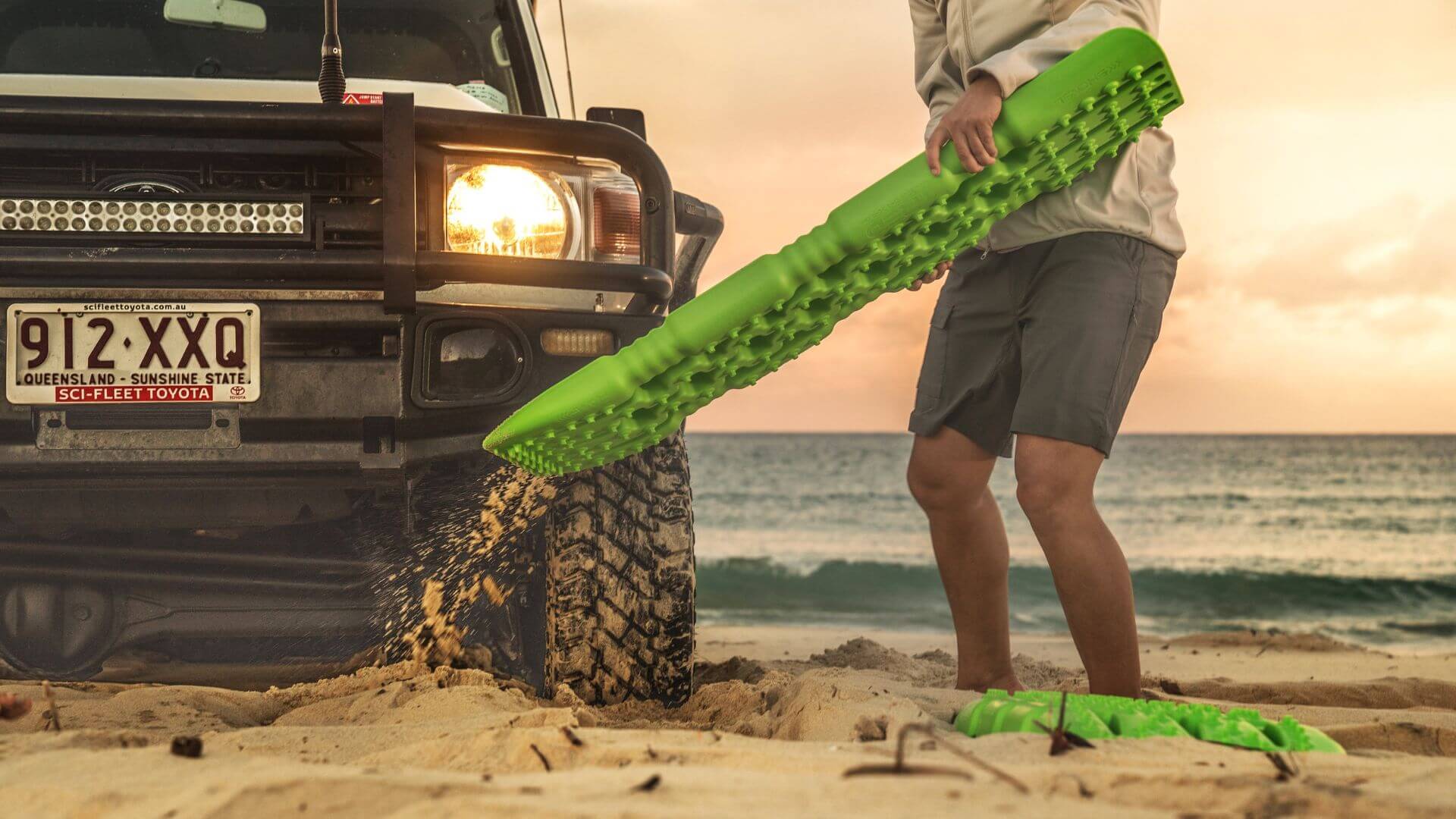
Let's face it - when 4WDing on sand, you're going to get bogged at some point, and it will have nothing to do with your skill level. What's important is to stay relaxed, because you have everything you need in your 4X4 to get going again, and in no time at all.
- First, reduce your wheel spin - the chances are you're just going to dig yourself further into the sand.
- Next, deflate your tyres just a little bit further. Using either your recovery tracks or a shovel, dig away the excess sand from your wheels.
- When you've done that, push the boards in front of the wheels that are slipping, and drive out.
- Inflate the tyres to the pressure they were prior to getting bogged - and away you go!
Sometimes, It might be necessary to keep deflating your tyres to 'bite' on your recovery boards and secure the grip necessary to get back on top of the sand. Again, always inflate to the previous pressure reading before continuing on your journey.
In serious cases, having some people help you push your 4X4 onto the recovery boards can make a real difference. NEVER attach a snatch strap to your towball or towbar - always attach it to the rated recovery points of your 4WD, and always follow the user instructions.
Finally, it's considered good form to help out anyone else who might be experiencing a bit of trouble. If you see someone stuck, do the right thing and see if they could use some help. Remember, what goes around, comes around - the shoe could very well be on the other foot one day.
When The Fun Is Done
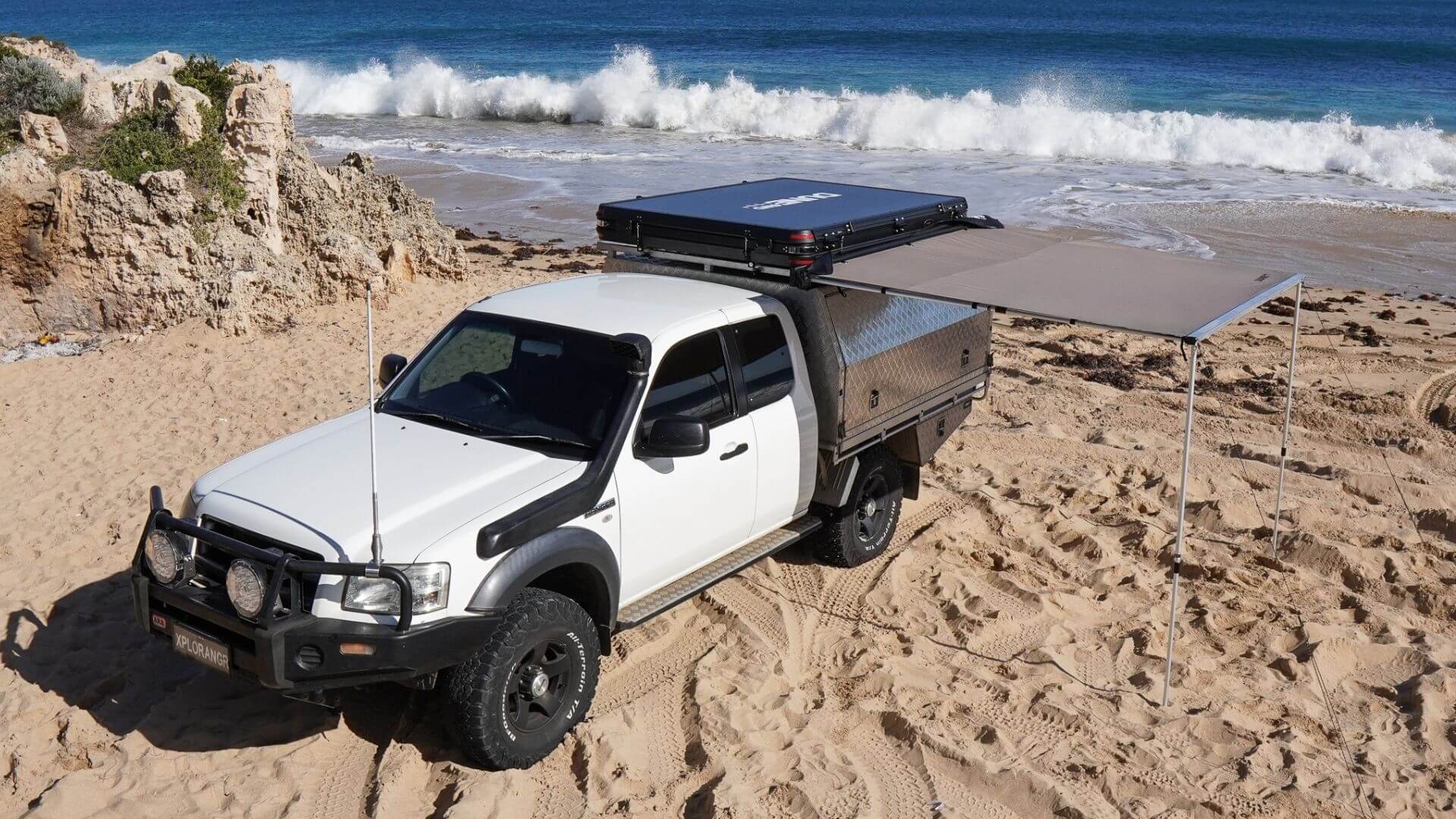
Caring for your 4WD after you come off the sand or the beach is something you shouldn't neglect. The first thing to do is to fire up your compressor and inflate your tyres back to the manufacturer's specs for road use.
It's important to wash your off-roader as soon as you can, to get the sand and saltwater from the joints and bodywork of the car. Again, treating the underside of your 4WD with lanolin is a great way to keep it in excellent condition.
In Conclusion
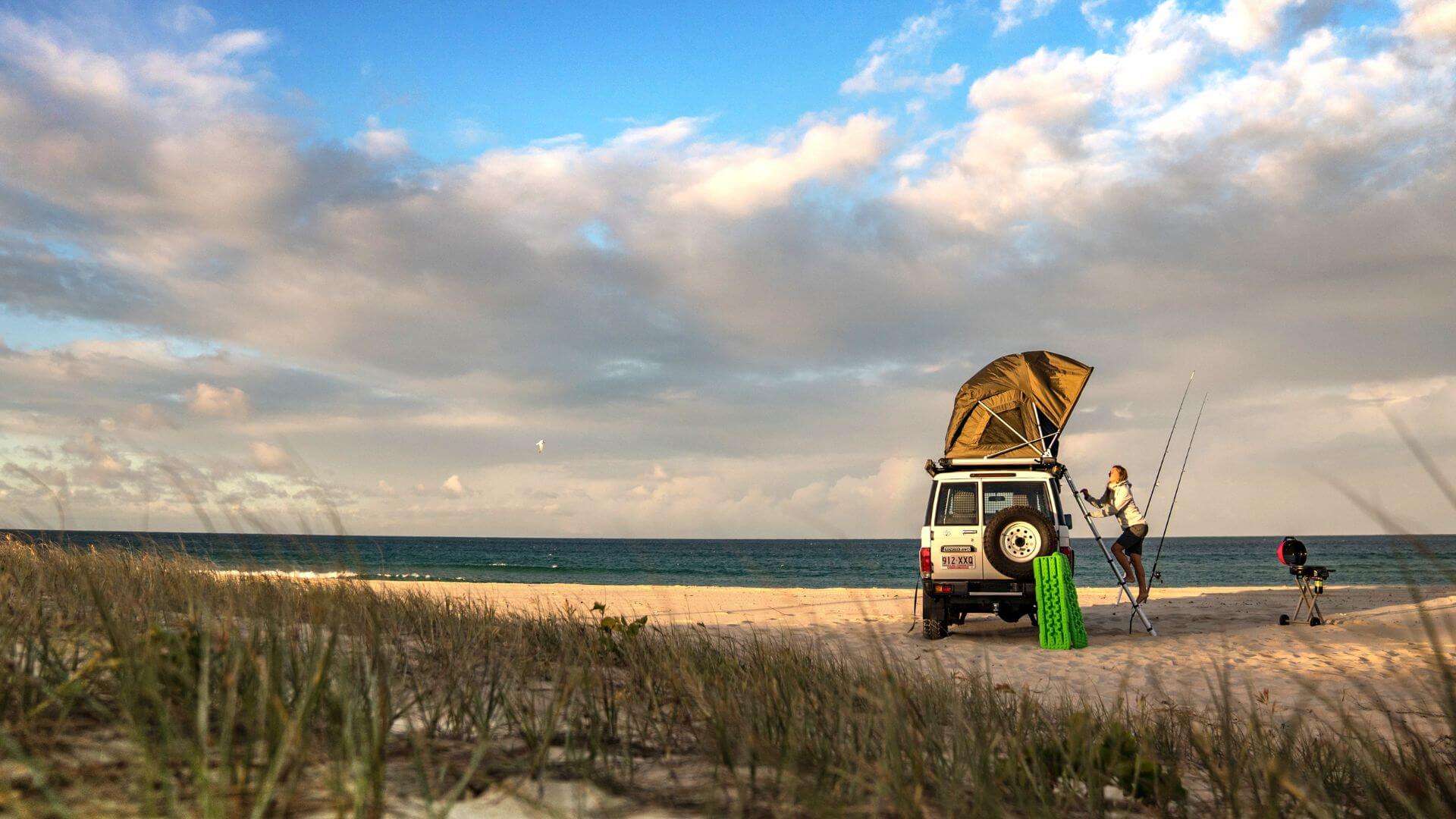
There's no doubt about it - 4WDing on sand is loads of fun! But it's equally important to know how to drive your 4X4 to avoid accidents, injuries or finding yourself in an unfortunate emergency situation.
Keep this guide handy before heading out on your next 4WD beach adventure, and you'll be prepped to enjoy the thrills without the headache.